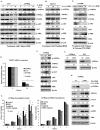Bitter Melon (Momordica charantia) Extract Inhibits Tumorigenicity and Overcomes Cisplatin-Resistance in Ovarian Cancer Cells Through Targeting AMPK Signaling Cascade
- PMID: 26487740
- PMCID: PMC5689379
- DOI: 10.1177/1534735415611747
Bitter Melon (Momordica charantia) Extract Inhibits Tumorigenicity and Overcomes Cisplatin-Resistance in Ovarian Cancer Cells Through Targeting AMPK Signaling Cascade
Abstract
Objective Acquired chemoresistance is a major obstacle in the clinical management of ovarian cancer. Therefore, searching for alternative therapeutic modalities is urgently needed. Bitter melon (Momordica charantia) is a traditional dietary fruit, but its extract also shows potential medicinal values in human diabetes and cancers. Here, we sought to investigate the extract of bitter melon (BME) in antitumorigenic and cisplatin-induced cytotoxicity in ovarian cancer cells.
Methods: Three varieties of bitter melon were used to prepare the BME. Ovarian cancer cell lines, human immortalized epithelial ovarian cells (HOSEs), and nude mice were used to evaluate the cell cytotoxicity, cisplatin resistance, and tumor inhibitory effect of BME. The molecular mechanism of BME was examined by Western blotting.
Results: Cotreatment with BME and cisplatin markedly attenuated tumor growth in vitro and in vivo in a mouse xenograft model, whereas there was no observable toxicity in HOSEs or in nude mice in vivo Interestingly, the antitumorigenic effects of BME varied with different varieties of bitter melon, suggesting that the amount of antitumorigenic substances may vary. Studies of the molecular mechanism demonstrated that BME activates AMP-activated protein kinase (AMPK) in an AMP-independent but CaMKK (Ca(2+)/calmodulin-dependent protein kinase)-dependent manner, exerting anticancer effects through activation of AMPK and suppression of the mTOR/p70S6K and/or the AKT/ERK/FOXM1 (Forkhead Box M1) signaling cascade.
Conclusion: BME functions as a natural AMPK activator in the inhibition of ovarian cancer cell growth and might be useful as a supplement to improve the efficacy of cisplatin-based chemotherapy in ovarian cancer.
Keywords: AMPK activator; Momordica charantia; bitter melon; chemoresistance; cisplatin; ovarian cancer.
© The Author(s) 2015.
Conflict of interest statement
Figures






Similar articles
-
MAP30 protein from Momordica charantia is therapeutic and has synergic activity with cisplatin against ovarian cancer in vivo by altering metabolism and inducing ferroptosis.Pharmacol Res. 2020 Nov;161:105157. doi: 10.1016/j.phrs.2020.105157. Epub 2020 Aug 16. Pharmacol Res. 2020. PMID: 32814169
-
Bitter melon (Momordica charantia) extract suppresses adrenocortical cancer cell proliferation through modulation of the apoptotic pathway, steroidogenesis, and insulin-like growth factor type 1 receptor/RAC-α serine/threonine-protein kinase signaling.J Med Food. 2012 Apr;15(4):325-34. doi: 10.1089/jmf.2011.0158. Epub 2011 Dec 22. J Med Food. 2012. PMID: 22191569
-
Bitter melon (Momordica charantia) extract inhibits breast cancer cell proliferation by modulating cell cycle regulatory genes and promotes apoptosis.Cancer Res. 2010 Mar 1;70(5):1925-31. doi: 10.1158/0008-5472.CAN-09-3438. Epub 2010 Feb 23. Cancer Res. 2010. PMID: 20179194
-
Promise of bitter melon (Momordica charantia) bioactives in cancer prevention and therapy.Semin Cancer Biol. 2016 Oct;40-41:116-129. doi: 10.1016/j.semcancer.2016.07.002. Epub 2016 Jul 21. Semin Cancer Biol. 2016. PMID: 27452666 Free PMC article. Review.
-
Multidimensional Uses of Bitter Melon (Momordica charantia L.) Considering the Important Functions of its Chemical Components.Curr Org Synth. 2025;22(4):516-530. doi: 10.2174/0115701794285586240523101245. Curr Org Synth. 2025. PMID: 40420786 Review.
Cited by
-
New Insights into Ferroptosis Initiating Therapies (FIT) by Targeting the Rewired Lipid Metabolism in Ovarian Cancer Peritoneal Metastases.Int J Mol Sci. 2022 Dec 3;23(23):15263. doi: 10.3390/ijms232315263. Int J Mol Sci. 2022. PMID: 36499591 Free PMC article. Review.
-
The Role of Bitter Melon in Breast and Gynecological Cancer Prevention and Therapy.Int J Mol Sci. 2023 May 17;24(10):8918. doi: 10.3390/ijms24108918. Int J Mol Sci. 2023. PMID: 37240264 Free PMC article. Review.
-
Nutraceutical Potential of Bitter Melon (Momordica charantia) on Cancer Treatment: An Overview of In Vitro and Animal Studies.Curr Issues Mol Biol. 2025 Jun 6;47(6):425. doi: 10.3390/cimb47060425. Curr Issues Mol Biol. 2025. PMID: 40699824 Free PMC article. Review.
-
Transcriptome and metabolome changes induced by bitter melon (Momordica charantia)- intake in a high-fat diet induced obesity model.J Tradit Complement Med. 2021 Aug 19;12(3):287-301. doi: 10.1016/j.jtcme.2021.08.011. eCollection 2022 May. J Tradit Complement Med. 2021. PMID: 35493312 Free PMC article.
-
Suppressive effects of Momordica charantia MAP30 on the senescence, proliferation and migration of bladder cancer cells mediated by CENPA.Sci Rep. 2025 Aug 13;15(1):29679. doi: 10.1038/s41598-025-14977-y. Sci Rep. 2025. PMID: 40804263 Free PMC article.
References
-
- Parmar MK, Ledermann JA, Colombo N, et al. Paclitaxel plus platinum-based chemotherapy versus conventional platinum-based chemotherapy in women with relapsed ovarian cancer: the ICON4/AGO-OVAR-2.2 trial. Lancet. 2003;361:2099-2106. - PubMed
-
- Siegel R, Ma J, Zou Z, Jemal A. Cancer statistics, 2014. CA Cancer J Clin. 2014;64:9-29. - PubMed
Publication types
MeSH terms
Substances
Grants and funding
LinkOut - more resources
Full Text Sources
Other Literature Sources
Medical
Miscellaneous

